What a nightmare. New puppies are supposed to be a joy, yet here you are at your wits end with a puppy screaming in their
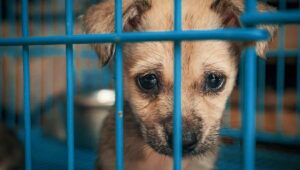
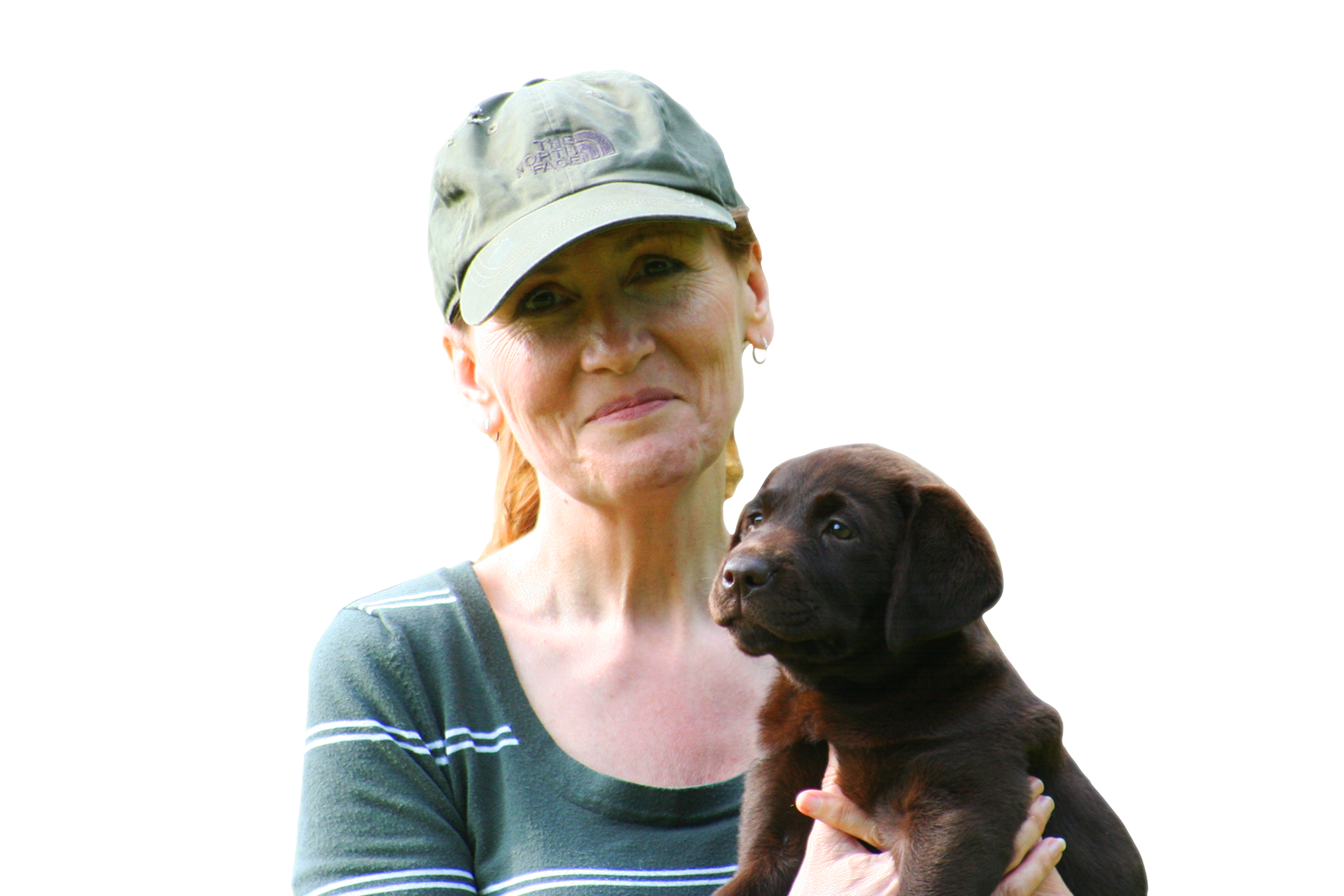

Written by: Pippa Mattinson
When we think about puppies and exercise, the first thing that springs to mind is usually walking.
For many people, walking the dog is a key part of bringing a canine friend into their lives, and one that they look forward to very much.

However, you'll need to be a little bit patient, because long walks are not suitable for very young puppies.
Going for a walk is fun, but fortunately it's not the only way to exercise a dog. There are many different forms of exercise that family dogs participate in.
These include indoor and outdoor opportunities for play and activity. And participation in more formal sports and games.
Types Of Exercise
Depending on the ages and type of dog, some of those activities are better than others. So we'll take a look at each one in turn.
The good news is that for the first few weeks after your puppy's arrival you really don't need to worry about providing an exercise routine or schedule. Young puppies that are allowed sufficient space, to play and explore, don't actually need formal exercise at all.
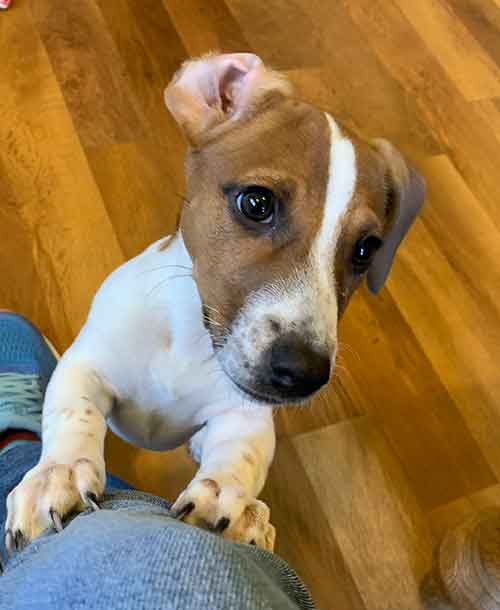
There is, in fact, a risk of over-exercising your puppy. So for certain types of exercise you will need to supervise, and set boundaries. As your puppy grows and matures, there will be increasing opportunities to participate in fun activities.
Exploring your home and yard is quite an adventure for a new puppy. Playing with with their toys, and generally romping around indoors will provide plenty of exercise for your little one.
You don't need to worry about setting limits on this type of activity. Unless they are persistently woken up by humans or other pets, puppies will sleep as much as they need. Just make sure that the pup has a quiet sleeping area where they can relax and rest, if they choose.
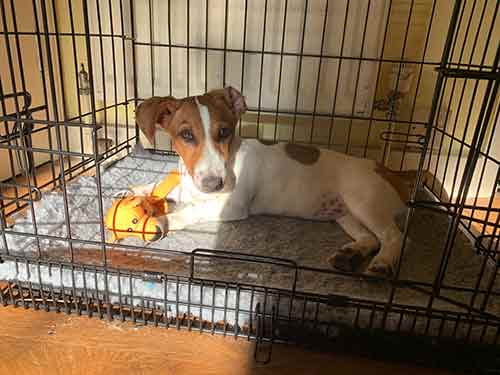
Sometimes a puppy will get over-excited with a toy.
For example, some puppies may get very excited with balls that they cannot easily pick up, and seem to get locked into an endless chasing cycle with the ball constantly dancing ahead of them.
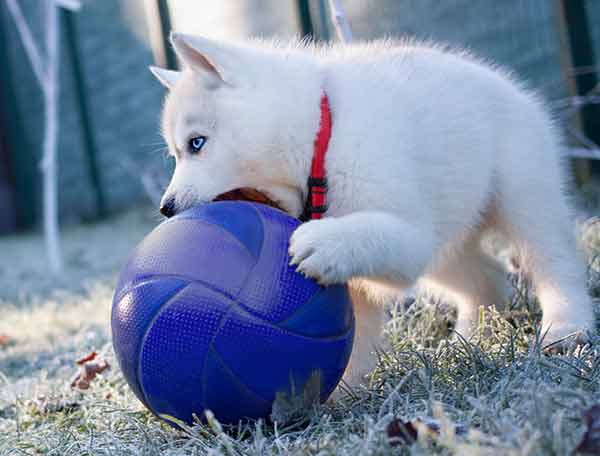
My Labrador Rachael (the puppy I am holding in the picture at the top of the page) would get very overexcited if we left her with a large ball for more than a few minutes!
If this happens with your puppy, put the toy away for a while and replace it with a more calming alternative.
Puppy games are a great way to stimulate your puppy's brain. The games we play with puppies to help develop their attention paying skills and their confidence, also provide exercise for your puppy.
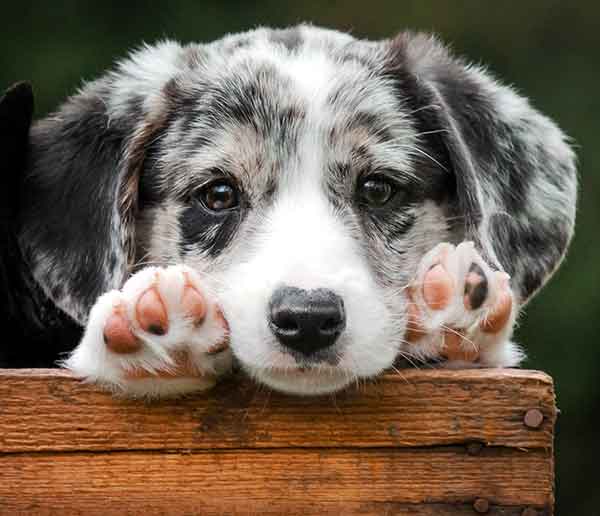
Each time you throw a treat, for example, your puppy has to run and fetch it. And many puppy games involve you moving around so the that puppy is actively moving after you.
If the weather is fine, a kiddie pool in your yard can be a fun way to give your puppy some exercise, and introduce them to getting wet. Many puppies will happily splash around and play in shallow water.
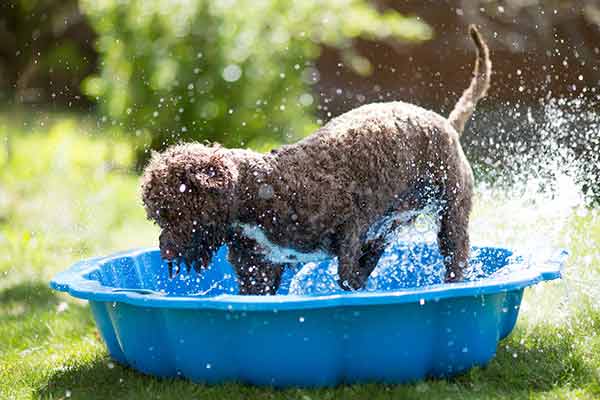
Just like small children, puppies should never be left alone with water.
If your puppy seems reluctant to join in, just reduce the quantity of water to an inch or less, and get in there with the puppy until their confidence builds up.
Playing with other dogs is an area where you can run into problems with a puppy. And where you need to be a bit cautious. Judge each situation individually.
Some older dogs play very nicely with puppies. Others can be too boisterous and too rough. Some dogs do not like puppies at all and could be aggressive towards a puppy that attempts to engage them in play.
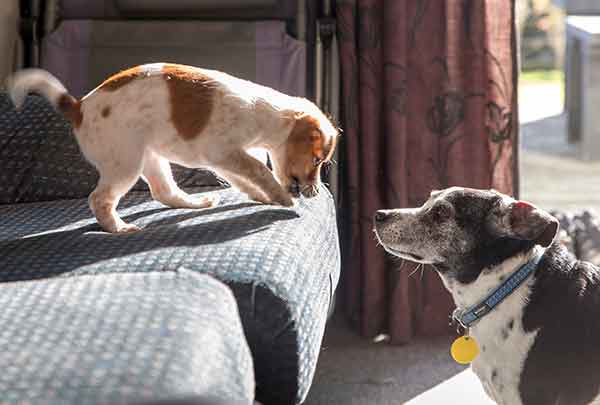
Well managed puppy classes can provide an opportunity for puppies to play together. But in a poorly managed class, smaller or less confident puppies may be bullied or frightened. So it's important to go along and watch a session before enroling your puppy.
Children, and some adults too, can get puppies very over-excited. And over-excited puppies are likely to start biting.
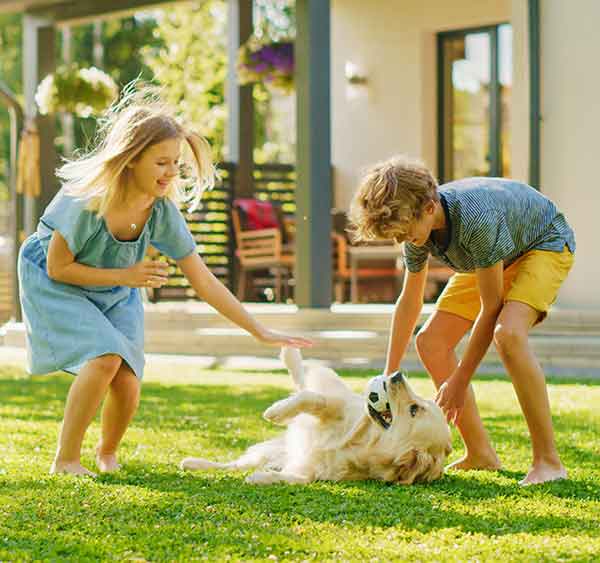
The main problem with rough and tumble play, especially between dogs and kids, is that dog play and human play are governed by very different rules.
Puppies for example like to tug on each other's fur when they play. Whereas your children may not appreciate having their hair pulled.
Teach Your Kid This Rule
When you want to stop playing with a puppy do this:
Stand up, plant your feet apart, fold your arms and keep still
Always stand up if a puppy starts to get rough and bite or bark at you.
To a dog, running away may mean "chase me". Small children may run from a dog when they are afraid and inadvertently trigger the chase.
Yelping and squealing in dog play means "I'm loving this, do it more!" Whereas children often do this when they want a game to stop or are scared.
To Help Kids Enjoy Their Puppy
Teach your children to play with their puppy through structured puppy games.
Show children how to reward a puppy for eye contact
Teach your children about the puppy promise
To a dog, getting down low on the ground is an invitation to play, children often crouch low, or curl up in a ball, when they have had enough.
When a dog has had enough of a game, they stand up tall, stiffen their body, and keep very still.
These differences mean that rough, physical play between dogs and kids often ends in tears, scratches and where puppies are concerned may end in biting.
Puppies love to be chased. But it's a much better idea to get your puppy to chase after you instead. Running away from people is not a habit we want our dogs to learn.
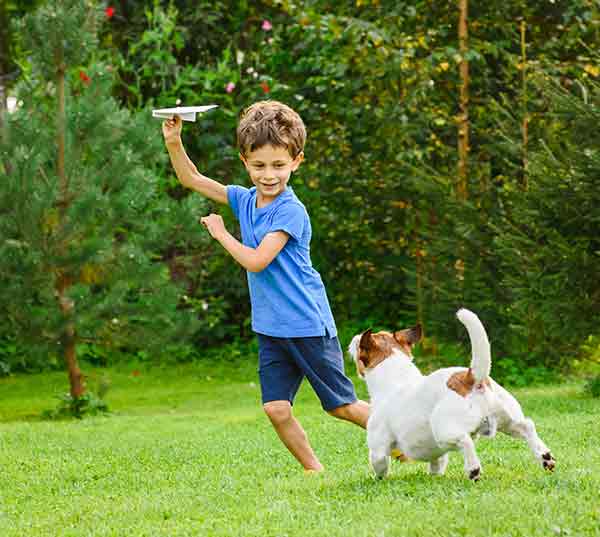
Instead, move a few feet away from your puppy when they are not looking, and when they look up and run towards you, crouch down and welcome them with a treat and a fuss.
Some puppies love chasing after a toy or soft ball, but small puppies tend to give up easily, if the toy goes too quickly or too far.
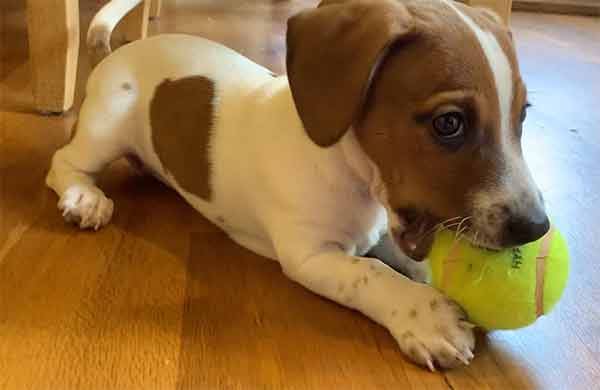
Adjust the game to the age of the puppy. Gently throwing a toy a foot or even a few inches, is enough for an eight week old puppy.
Let the puppy play with the toy if they want to, you can teach them to hand it over later on.
Most veterinarians have seen some nasty mouth and throat injuries in dogs from fetching sticks, so you might want to consider choosing a toy instead
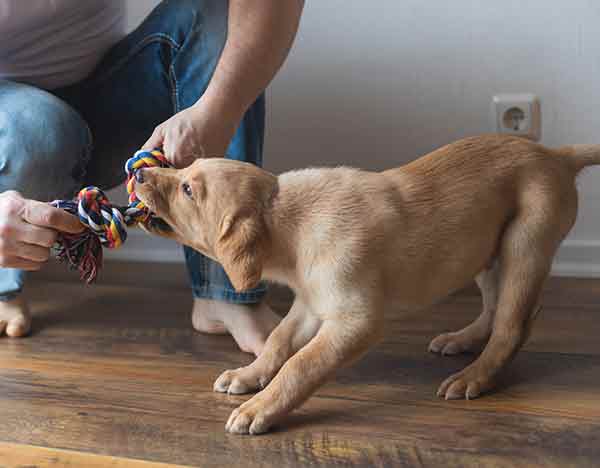
Tugging is great exercise. Tugging games improve balance, build strength and are a great way to bond with a puppy.
Once a puppy has been introduced to tug, a tugging session makes a great reward and a good alternative to edible treats.
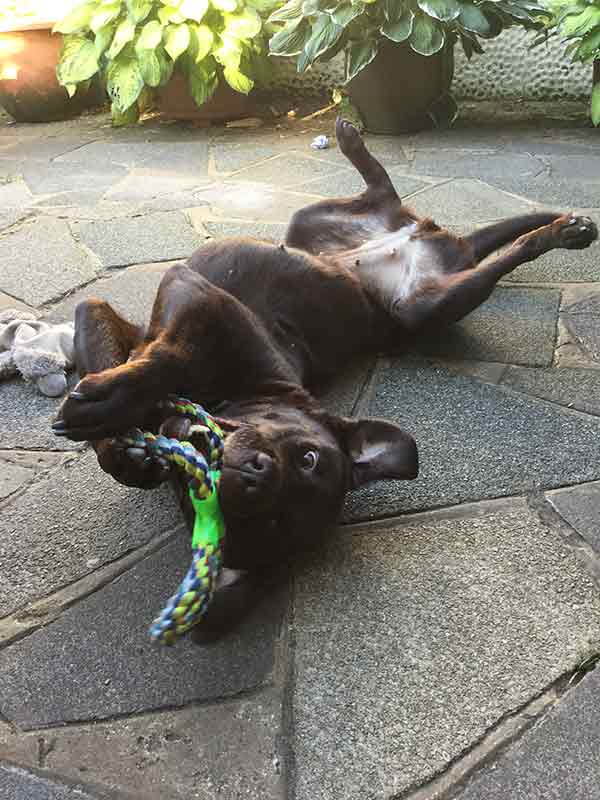
Rachael's favorite tug toy
Tugging needs to be played with care to avoid accidental nips, and puppies need to be introduced to the game in stages
Obedience training is not just an important part of a puppy's education, it is also a great source of exercise. Most obedience sessions involve physical activity to varying degrees as puppies learn to walk and run to, from, and with, their trainer.
Agility training is another great source of exercise, both for you and your dog. And is a great way of entertaining your dog and building a bond between you.
Some aspects of training need to wait until your dog has stopped growing. There is a risk of damage to a growing puppy's joints when repeatedly jumping. We'll look at this a bit more below in ages and stages.
Many new puppy parents are disappointed to be told that they should not take their puppy for walks yet. The reason for this advice centers largely on concerns about hip dysplasia. This is a serious joint condition that mainly affects medium to large dogs.
Hip dysplasia can cause severe pain, is not curable, can shorten a dog's life and be expensive to treat.
The Walking Rule
From two months of age puppies can walk for:
Five Minutes Per Day For Each Month Of Age
So that's twenty minutes for a four month old puppy
While the genes that predispose a dog to hip dysplasia are inherited, there is a concern that over-exercising a puppy may increase the risk of a puppy developing the disease.
There are many forms of exercise that are much more suitable for a young puppy. So it makes sense to observe the simple walking rule above.
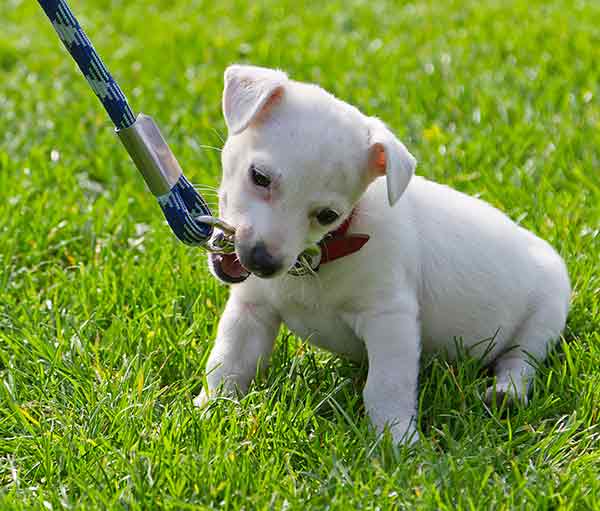
This rule applies to continuous walking where the puppy is constantly on the move. Not to relaxed play in the yard or home, where the puppy can stop and start as they please
Now we are in serious territory. If you are a keen runner it's only natural that you'd like your dog to accompany you.
For some breeds of dog a five mile run is a brilliant way to start their day. But with others you need to exercise caution. Dogs with flatter faces, French Bulldogs for example, may have impaired breathing and can overheat easily.
You'll need to wait until your dog is mature before embarking on your jogging program, it isn't good for your growing dog's joints to pound the sidewalk.
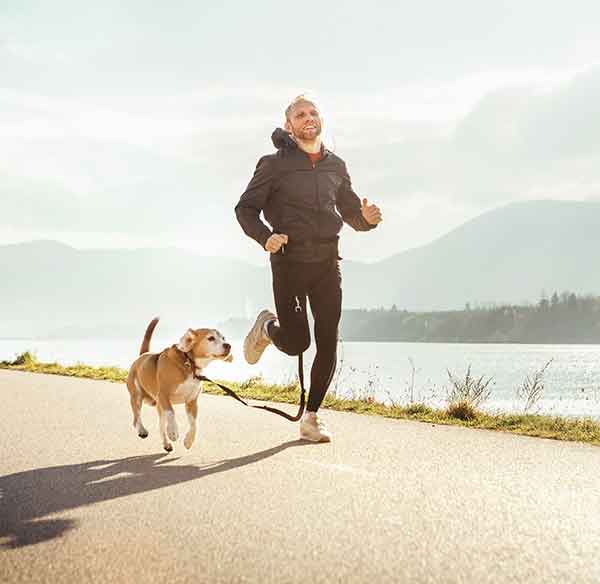
Make sure you run in the cool of the evening or early morning. Even dogs that are supremely designed for running can suffer in warm weather. Remember that your dog can't take off their coat! And always check with your veterinarian before embarking on a serious program of running with your dog.
Just like humans, dogs need to be introduced to hard exercise gradually and in a structured way. Remember that 'going for a run' isn't a natural pattern of exercise for a dog. Their natural inclination is to stop and sniff, move on a bit, then stop and sniff some more. Running continuously for extended periods of time requires stamina that some dogs can develop with time and practice.
Most dogs swim instinctively and competently when they are out of their depth. There are some important exceptions (see below). While you don't have to teach a dog how to swim, it is a good idea to introduce your dog to swimming in stages, if you want your dog to enjoy it.
The first step is to get your puppy comfortable with shallow water. Splashing through puddles or shallow streams, playing in the kiddie pool, or with a shallow basin of water.
Important!
Some dogs from brachycephalic (flat-faced) breeds may be unable to swim, or may be poor swimmers.
Never leave a brachycephalic dog unsupervised around water.
Brachycephalic breeds include (but are not limited to) the French Bulldog, the Pug, and the English Bulldog.
These dogs may need flotation aids and should always wear a life jacket near deep water.
Warm weather is the best time to introduce a dog of any age to deeper water. Choose a location where you can get into the water with your dog and reassure them.
Young dogs often swim frantically at first, and with lots of splashing. With practice your dog will soon be cruising smoothly through the water like an otter.
And then you'll be able to consider sporting activities like dock diving!
With very young puppies you need to put limits on vigorous interactive play. Especially on play that involves children or other dogs. Or any type of play that the puppy finds very exciting. Think in terms of minutes rather than hours.
Tips For 8 Week Puppies
Five minutes of continuous vigorous play with another dog is enough for most new puppies.
Give older dogs an escape route.
Avoid formal walks until the puppy is older.
When it comes to the more traditional 'dog walk' there is an often quoted rule of thumb: From 8 weeks old, five minutes of exercise per day for every month of a puppy's age. So that would be 15 minutes at 3 months, 20 minutes a day at 4 months and so on.
In practice, that rule is fine for puppies from around six months old, while puppies under 4-5 months old simply don't need 'walks' at all in the traditional sense. They can get all the exercise they need through play, games and training.
As your puppy reaches maturity, consider aiming for two exercise sessions per day. Most adult dogs benefit from a walk each morning and evening.
With puppies, many short periods of playful activity each day is more beneficial than a longer session.
Puppies need many trips outside for toileting purposes, and a short play session outside can easily be combined with these daytime outings.
Too much exercise may be harmful to young puppies. Puppies bones are softer than those of adult dogs, and the growth plates in their joints are vulnerable to injury. Joint problems such as hip dysplasia, and elbow dysplasia may be exacerbated or even triggered by with over-exercise in young puppies.
While it's true that some puppies do seem to survive unharmed when over-exercised, there seems little point in taking a chance with your precious pup. Especially when there are so many other ways to have fun and to build up your puppy's strength and endurance gradually.
Some dogs need special care when it comes to exercise. Most of these are dogs that have a body shape or size that disadvantages them in some way.
For optimum health and fitness, dogs need a body that can lose heat effectively and absorb the impact from running, twisting and jumping, without damage. Think of the body shape of a wolf or coyote. Long muzzled and with a backbone and leg length in similar proportions.
Dogs cool themselves via a complex network of thin bones inside their muzzles, coupled with the action of panting.
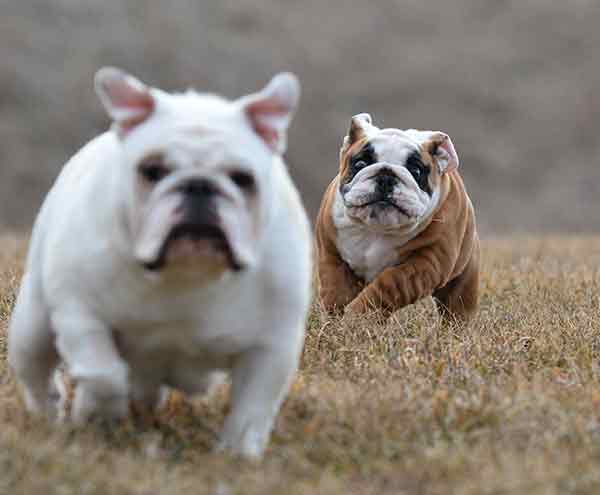
Dogs, such as Pugs and Bulldogs that have very short muzzles can have serious problems cooling themselves, and may suffer from additional respiratory issues.
Dogs with very short legs in relation to their spine, such as Dachshunds, may be easily injured. Especially if allowed to jump from much of a height.
It's a good idea to discourage long-backed puppies from jumping, and to lift them in and out of vehicles or raised surfaces.
Just like people, dogs can suffer from heart disease, cancer, epilepsy and other health problems that may need special consideration when it comes to exercise.
If you know or suspect your dog has a health problem, its very important to seek out veterinary advice about the kinds of exercise that your dog can participate in. And for any dog, a vet check up is a good plan before taking them along on endurance runs or long hikes.

What a nightmare. New puppies are supposed to be a joy, yet here you are at your wits end with a puppy screaming in their

Puppies pee and poop a lot! Potty training teaches your puppy where to eliminate, and a good potty training system helps you manage your puppy
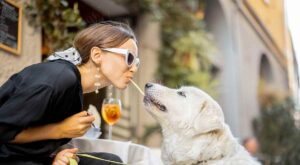
Many of the things that dogs need to stay well, and to be contented, are free. And most of them don’t take too much of

Inbred dogs are bred from parents that have a close genetic connection. These can be as close as parent to child, cousin to cousin, or

Poop eating is one of the worst things dogs do, but although disgusting this is a surprisingly common problem. Working out how to stop your
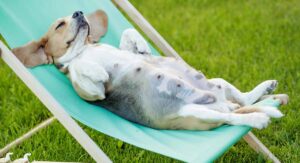
The dog pregnancy calendar is 63 days or 9 weeks long on average. It starts at the point of ovulation, and ends with the puppies’
To read more puppy feeding articles, check out our library of breed specific puppy feeding guides
Recommended: